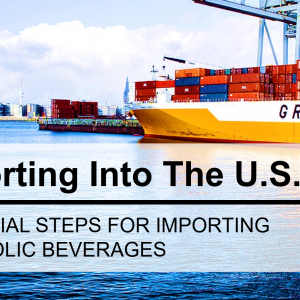Globalization has contributed to a beverage business environment where geographical boundaries are blurred. The exchange of an ingredient or finished beverage can occur with just the click of a button and advice from an internationally-known industry expert is available instantly via a video chat on your mobile phone.
Opportunities for international commerce are rapidly changing the playing field for beverage entrepreneurs who can look almost anywhere for customers as well as for the talent, ingredients, packaging, and ideas that will differentiate and provide a competitive advantage for their product. The more you widen your perspective and options, the better your chances are of finding a way to stand out and stay successful.
The increasingly global nature of the beverage business can be both rewarding and challenging. Throughout my 15 years working in the Asia-Pacific (APAC) food and beverage industry, I’ve worked with brands of all sizes and stages from various countries on optimizing strategies to formulate, produce, distribute, and grow successful products both locally and globally. Here are a few critical factors to remember when considering incorporating an international element into your beverage business plan.
1. Simplify with Standards
The experience of flavor and color differs from person to person and is influenced and contextualized by culture. If an Indian says, “I don’t want a sweet product,” the amount of sugar or sweetness they are envisioning will vary significantly from what someone from Europe may interpret as sweet. The same is true when it comes to describing a color as bright or vibrant. Especially when working across different countries, it’s vital to establish and communicate standard benchmarks that ensure everyone is on the same page.
For flavor experiences like sweetness, it comes down to the numbers. We ask things like, “Would you say five grams of sugar in one hundred milliliters of water is sweet? Or is it more like 20 grams of sugar in one hundred milliliters?” We have to dig into the details to understand how someone else might be interpreting a description and then move forward based on that understanding. With colors, we’ll do the same with shade cards to standardize brightness and intensity.

Developing and communicating standards for how subjective experiences are described helps to keep everyone moving in the same direction. Every exchange you save by communicating succinctly, decreases the number of samples that need to be created and increases the speed and efficiency of your formulation process.
2. Speak the same language
Language barriers can lead to poor communication, fear, and resulting business risk. I’ve learned that if there is a project where there is not a universal language that every team member can communicate in or have a reliable translator for, it is too big a risk to take on. Communication is such a vital and constant part of a successful beverage project especially in a remotely handled project, that you can’t afford to add in the challenge of a major language barrier without adequate planning around translation.
If I’m having a difficult time early-on understanding what a customer wants because
we are unable to communicate clearly with one another, I know that the project will probably not work out in the long-run. Think through the time and energy it will take to communicate with the team members and partners you will need for your international strategy and plan accordingly.

3. Know that trends vary across regions
Although some trends are labeled “global,” it’s important to remember that the rate and magnitude at which they are adopted is different across countries. Factors like cultural values and level of economic development greatly influence buyer behavior. Even as the APAC region begins to move towards more organic, natural, and healthy products, Southeast Asia is just now moving away from the artificial colors and flavors that consumers in the U.S. and Europe have been steadily abandoning for years. Consumers in emerging markets have different needs and tend to make purchases based on external payoffs rather than internal satisfaction or release. For example, many developing countries struggle with potable water, so packaged drinking water is growing massively in those regions. As incomes rise, so does the taste for more indulgent, transformative products and brands. Consumers’ perception of a brand’s size also differs depending on its history and stage of development. Many developed markets are embracing local, niche, and innovative brands, while consumers in developing markets will often lean towards the scale and reassurance of bigger, established brands. Understanding the factors that influence the lifestyle and trends in a specific country is an integral part of a successful international strategy.
4. Understand industry structure
You can have an excellent idea or product, but if you can’t find someone to produce it, you have a problem. In India, the beverage market is growing about 20 to 25% year-over-year, but the manufacturing units are not growing as quickly as the demand is. The biggest pain point for many of our clients, not only in India but the rest of Asia, is finding good quality manufacturing facilities. So many of them have excellent beverage concepts and plenty of financing, but they don’t have an equally good manufacturing unit to support them with producing quality products. So, especially in India, businesses struggle. You can develop outstanding formulations, and develop an entire marketing pack, but be unable to push the product into a market because you can’t find a suitable manufacturing partner. You need to understand the capacity constraints you might encounter in different geographies and find creative ways to work around those limitations. Having a global network of manufacturers and understanding how to assess their capabilities and quality is extremely important.
It’s also good to remember that conditions are constantly changing and what is perceived as a challenge can also be an opportunity. Right now, the Southeast Asian region is making a push to grow manufacturing units, and the governments have started making policies and giving subsidies to help manufacturers to set up their shops. So, the landscape could look dramatically different in the next couple of years.
5. Lock-in on logistics
When you’re working across countries, the details and logistics can make or break a project. One misstep in shipping or labeling can get a product hung up in transport or stuck in customs, costing you valuable time and money. An international team and resources can add immense value to your beverage product and business plan, but they must be carefully organized and coordinated to ensure you’re optimizing the opportunity while mitigating the risks. Planning ahead and communicating consistently are essential habits to build as you tackle the added challenges of managing beverage logistics across countries.
![]()
6. Beware of built-in costs
Depending on how the industry has evolved within a particular country or region, cost structures can be vastly different and have a significant impact on your business. Distribution in the APAC region is very localized. Your ability to get your products on shelves is influenced by tiered distribution networks that can be very exclusive. There is a long list of people you need to pay commission to, and it’s not uncommon for a startup to pay more than 50% of the cost of the product as commissions on various levels. This has a big influence on MRP and margins. As modern retailers like Walmart enter these markets, some of this cost structure may start to shift, but right now, the market is still dominated by mom and pop shops and the distribution networks set up to reach them. Being aware of the industry structures and practices within a region and the influence they will have on your costs, strengthens your distribution and pricing strategies.
Starting a beverage venture is exciting and rewarding. Every project brings its own set of challenges and opportunities, and there is never a dull moment. Remembering these tips will help you tune in to the added factors and facets that come along with expanding beyond your geographical borders.
As with any beverage endeavor, having an experienced partner on your beverage journey can decrease your stress and increase your probability of success. Contact MyDrink Beverages to learn how we can help you bring your beverage idea to life.


